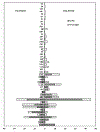Invasive disease potential of Streptococcus pneumoniae serotypes before and after 10-valent pneumococcal conjugate vaccine introduction in a rural area, southern Mozambique
- PMID: 31575493
- PMCID: PMC10962395
- DOI: 10.1016/j.vaccine.2019.09.079
Invasive disease potential of Streptococcus pneumoniae serotypes before and after 10-valent pneumococcal conjugate vaccine introduction in a rural area, southern Mozambique
Abstract
Background: Invasive pneumococcal disease (IPD) is a significant cause of morbidity and mortality among children worldwide. In April 2013, Mozambique introduced 10-valent PCV (PCV10) into the National Expanded Program on immunization using a three-dose schedule at 2, 3, and 4 months of age. We aimed to evaluate the invasive disease potential of pneumococcal serotypes among children in our region before and after PCV10 introduction.
Methods: We used data from ongoing population-based surveillance for IPD and cross-sectional pneumococcal carriage surveys among children aged <5 years in Manhiҫa, Mozambique. To determine the invasive disease potential for each serotype pre- and post-PCV10 introduction, odds ratios (OR) and 95% confidence intervals (95% CI) were calculated comparing serotype-specific prevalence in IPD and in carriage. For each serotype, OR and 95% CI > 1 indicated high invasive disease potential and OR and 95% CI < 1 indicated low invasive disease potential.
Results: In the pre-PCV10 period, 524 pneumococcal isolates were obtained from 411 colonized children and IPD cases were detected in 40 children. In the post-PCV10 period, 540 pneumococcal isolates were obtained from 507 colonized children and IPD cases were detected in 30 children. The most prevalent serotypes causing IPD pre-PCV10 were 6A (17.5%), 6B (15.0%), 14 (12.5%), 23F (10.0%) and 19F (7.5%), and post-PCV10 were 6A (36.7%), 13 (10%), 1 (10.0%), 6B (6.7%) and 19A (6.7%). Serotypes associated with high invasive disease potential pre-PCV10 included 1 (OR:22.3 [95% CI 2.0; 251.2]), 6B (OR:3.1 [95% CI 1.2; 8.1]), 14 (OR: 3.4 [95% CI 1.2; 9.8]) and post-PCV10 included serotype 6A (OR:6.1[95% CI 2.7; 13.5]).
Conclusion: The number of serotypes with high invasive disease potential decreased after PCV10 introduction. Serotype 6A, which is not included in PCV10, was the most common cause of IPD throughout the study and showed a high invasive potential in the post-PCV10 period.
Keywords: Invasive disease potential; Invasive pneumococcal disease; Nasopharyngeal carriage; Pneumococcal conjugate vaccine.
Copyright © 2019. Published by Elsevier Ltd.
Conflict of interest statement
Declaration of Competing Interest
The authors declare that they have no known competing financial interests or personal relationships that could have appeared to influence the work reported in this paper.
Figures


Similar articles
-
Early Declines in Vaccine Type Pneumococcal Carriage in Children Less Than 5 Years Old After Introduction of 10-valent Pneumococcal Conjugate Vaccine in Mozambique.Pediatr Infect Dis J. 2018 Oct;37(10):1054-1060. doi: 10.1097/INF.0000000000002134. Pediatr Infect Dis J. 2018. PMID: 30216295 Free PMC article.
-
Impact of the 10-valent pneumococcal conjugate vaccine (PCV10) on pneumococcal carriage in healthy children and children with acute otitis media and pneumonia: emergence of serotypes 3, 6C and 19A in Croatia.Vaccine. 2025 Mar 19;50:126848. doi: 10.1016/j.vaccine.2025.126848. Epub 2025 Feb 7. Vaccine. 2025. PMID: 39921981
-
Nasopharyngeal carriage of Streptococcus pneumoniae among children and their household members in southern Mozambique five years after PCV10 introduction.Vaccine. 2025 Feb 15;47:126691. doi: 10.1016/j.vaccine.2024.126691. Epub 2025 Jan 8. Vaccine. 2025. PMID: 39787794 Free PMC article.
-
Effects of PCV10 and PCV13 on pneumococcal serotype 6C disease, carriage, and antimicrobial resistance.Vaccine. 2024 Apr 30;42(12):2983-2993. doi: 10.1016/j.vaccine.2024.03.065. Epub 2024 Mar 28. Vaccine. 2024. PMID: 38553292
-
Streptococcus pneumoniae serotype 19A: worldwide epidemiology.Expert Rev Vaccines. 2017 Oct;16(10):1007-1027. doi: 10.1080/14760584.2017.1362339. Epub 2017 Aug 28. Expert Rev Vaccines. 2017. PMID: 28783380 Review.
Cited by
-
Serotype distribution of invasive pneumococcal disease from countries of the WHO Africa, Americas, Eastern Mediterranean, South-East Asia, and Western Pacific regions: a systematic literature review from 2010 to 2021.Front Public Health. 2024 Jul 10;12:1402795. doi: 10.3389/fpubh.2024.1402795. eCollection 2024. Front Public Health. 2024. PMID: 39050608 Free PMC article.
-
Serotypes and Clonal Composition of Streptococcus pneumoniae Isolates Causing IPD in Children and Adults in Catalonia before 2013 to 2015 and after 2017 to 2019 Systematic Introduction of PCV13.Microbiol Spectr. 2021 Dec 22;9(3):e0115021. doi: 10.1128/Spectrum.01150-21. Epub 2021 Dec 8. Microbiol Spectr. 2021. PMID: 34878302 Free PMC article.
-
Approaching In Vivo Models of Pneumococcus-Host Interaction: Insights into Surface Proteins, Capsule Production, and Extracellular Vesicles.Pathogens. 2021 Aug 28;10(9):1098. doi: 10.3390/pathogens10091098. Pathogens. 2021. PMID: 34578131 Free PMC article.
-
Quality of antibody responses by adults and young children to 13-valent pneumococcal conjugate vaccination and Streptococcus pneumoniae colonisation.Vaccine. 2022 Nov 28;40(50):7201-7210. doi: 10.1016/j.vaccine.2022.09.069. Epub 2022 Oct 6. Vaccine. 2022. PMID: 36210249 Free PMC article.
-
Serotype 1 pneumococcus: epidemiology, genomics, and disease mechanisms.Trends Microbiol. 2022 Jun;30(6):581-592. doi: 10.1016/j.tim.2021.11.007. Epub 2021 Dec 20. Trends Microbiol. 2022. PMID: 34949516 Free PMC article. Review.
References
-
- Wahl B, O’Brien KL, Greenbaum A, Majumder A, Liu L, Chu Y, et al. Burden of Streptococcus pneumoniae and Haemophilus influenzae type b disease in children in the era of conjugate vaccines: global, regional, and national estimates for 2000–15. Lancet Glob Heal 2018;6:e744–57. 10.1016/S2214-109X(18)30247-X. - DOI - PMC - PubMed
Publication types
MeSH terms
Substances
Grants and funding
LinkOut - more resources
Full Text Sources
Medical
Miscellaneous

